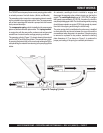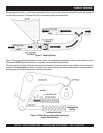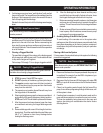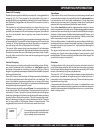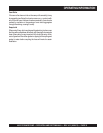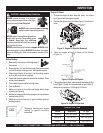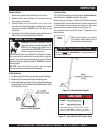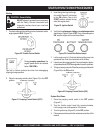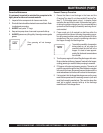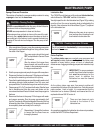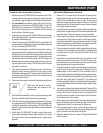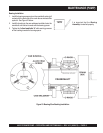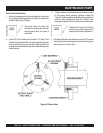
MAYCO C30HDZ PUMP — OPERATION AND PARTS MANUAL — REV. #12 (04/03/12) — PAGE 35
Gasoline Check
1. Remove the gasoline cap located on top of fuel tank.
2. Handle Fuel in a safety container. If the container does not
have a spout use a funnel.
3. Visually inspect to see if fuel level is low. If fuel is low,
replenish with unleaded fuel. When refueling, be sure to use
a strainer for filtration. DO NOT top-off fuel. Wipe up any
spilled fuel.
4. Pay attention to the fuel tank capacity when replenishing fuel.
Refer to the fuel tank capacity listed in Table 5.
INSPECTION
Lubrication Box
The C30HDZ model features a fully enclosed
lubrication box,
which utilizes the
"splash"
method of lubrication.
Before using your new pump, 7 gallons of SAE 30 motor oil must
be added directly into the lubrication box. Visually inspect the oil
in the lubrication box by making sure the oil is at the correct
operating level as indicated by the dip stick (Figure 16).
Also reference the oil level decal (Figure 17) adjacent to the
lubrication box.
Figure 16. Lubrication Box Dipstick
Figure 17. Lubrication Box Oil Caution Decal
NOTE
Gasoline
is extremely flammable, and its
vapors can cause an explosion if ignited. DO
NOT start the engine near spilled fuel or
combustible fluids. DO NOT fill the fuel tank
while the engine is running or hot.
DO NOT overfill tank, since spilled fuel could ignite if it comes
into contact with hot engine parts or sparks from the ignition
system. Store fuel in approved containers, in well-ventilated
areas and away from sparks and flames. NEVER use fuel as a
cleaning agent.
DO NOT smoke while refueling, motor fuels are highly
flammable and can be dangerous if mishandled.
WARNING - Explosive Fuel
LOW
NORMAL
Beforestarting engine, check that the oil level
inside the “ ” is within the indicated
operating range. Recommended oil type SAE 30.
LUBE BOX
1”
CAUTION
DCL 152
Make sure the pump is on a secure
level surface when checking the oil
level inside the lubrication box.
CAUTION -
Checking Lubrication Oil Levels
The oil level must be
checked daily
to ensure adequate oil
level and oil cleaniness.
Figure 19. V-Belt Deflection
V-Belt Deflection
1. Visually inspect the V-belt for cracks, fraying, wear or oiliness.
2. Make sure V-belt does not the bottom the pulley groove.
3. Check the V-belt tension (Figure 19) by pushing midway through
the two pulleys. The V-belt deflection should be between .300 to
.472 inches (8 to 12 mm).



